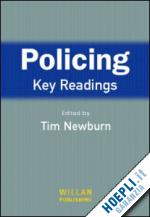Introduction, List of abbreviations, Acknowledgements Part A: The Emergence and Development of the Police Introduction 1. The demand for order in civil society, Allan Silver 2. Police and people: the birth of Mr Peel's 'blue locusts', Michael Ignatieff 3. Cops and Bobbies, 1830-1870, Wilbur R. Miller 4. A 'new police' in Australia, Mark Finnane 5. The emergence of the police - the colonial dimension, Mike Brogden 6. The emergence of the police - explaining police reform in eighteenth and nineteenth century England, John Styles 7. The evolving strategy of policing, George L. Kelling and Mark H. Moore 8. The evolving strategy of police: a minority view, Hubert Williams and Patrick V. Murphy Part B: The Role and Function of the Police Introduction 9. The police as peace officers, Michael Banton 10 Responsibilities of the police, William Westley 11. What do the police do? David H. Bayley 12 Florence Nightingale in pursuit of Willie Sutton: a theory of the police, Egon Bittner 13. The paradox of dispossession: skid row at night, William Ker Muir Jr 14. The police: mandate, strategies, and appearances, Peter K. Manning 15. The police as reproducers of order, Richard V. Ericson 16. The investigative function, P. Greenwood, J.M. Chaiken and J. Petersilia Part C: Police Culture Introduction 17. A sketch of the policeman's 'working personality', Jerome Skolnick 18. The asshole, John Van Maunen 19. Street cops and management cops: the two cultures of policing, Elizabeth Reuss-lanni and Francis A.J. Lanni 20. Culture as figurative action, Clifford Shearing and Richard Ericson 21. Changing police culture, Janet Chan 22. Police (canteen) sub-culture: an appreciation, P.A.J. Waddington Part D: Policing Strategies Introduction 23. Improving policing: a problem-oriented approach, Herman Goldstein 24. Who ya gonna call? The police as problem-busters, John E. Eck and William Spelman 25. Community policing in Chicago, Wes Skagan and Susan Hartnett 26. The rhetoric of community policing, Carl B. Klockars 27. Broken windows: the police and neighborhood safety, James Q. Wilson and George L. Kelling 28. Crime is down in New York City: blame the police, William J. Bratton 29. Beyond zero tolerance, David Dixon 30. Reforming to preserve: Compstat and strategic problem solving in American policing, David Weisburd, Stephen D. Mastrofski, AnnMarie McNally, Rosann Greenspan and James Willis 31. Sizing up COMPSTAT: an important administrative innovation in policing, Mark H. Moore 32. The policing of risk, Richard V. Ericson and Kevin D. Haggerty Part E: Deviance, Ethics and Control Introduction 33. The beating of Rodney King, Jerome Skolnick and James Fyfe 34. The Dirty Harry problem, Carl B. Klockars 35. Gratuities and corruption, John Kleinig 36. Police accountability revisited, Geoffrey Marshall 37. The legal regulation of policing, David Dixon Part F: The Emerging Pattern of Policing Introduction 38. Policing a postmodern society, Robert Reiner 39. Policing, politics and postmodernity, Pat O'Malley 40. The future of policing, David H. Bayley and Clifford D. Shearing 41. The transformation of policing? Understanding current trends in policing systems, Trevor Jones and Tim Newburn 42. Women in control? Frances Heidensohn 43. The new surveillance, Gary T. Marx 44. The thick green line: the growing involvement of military forces in domestic law enforcement, Colonel Charles J. Dunlap Jr 45. Cops and spooks: the uneasy partnership, Jean-Paul Brodeur Index











